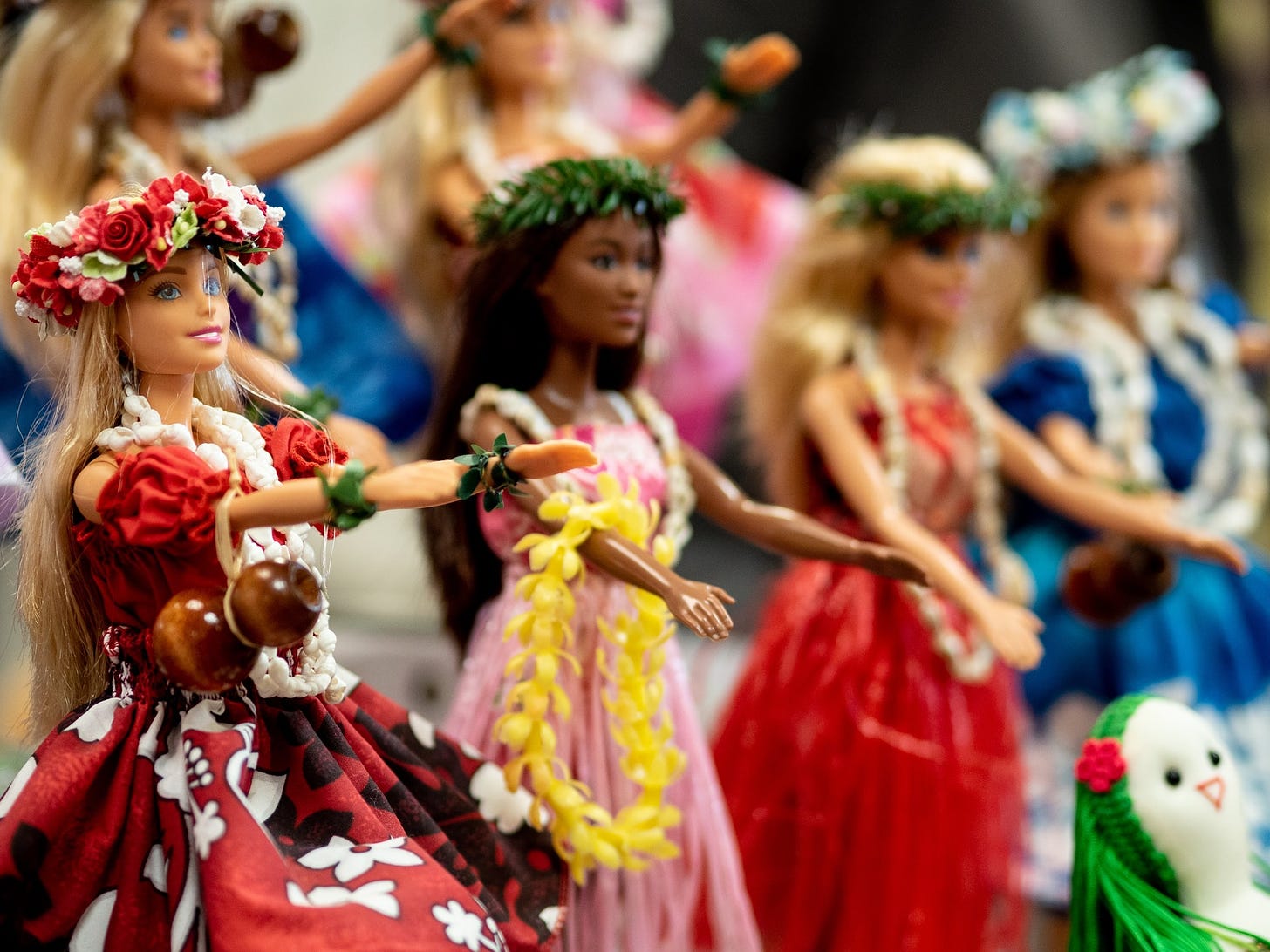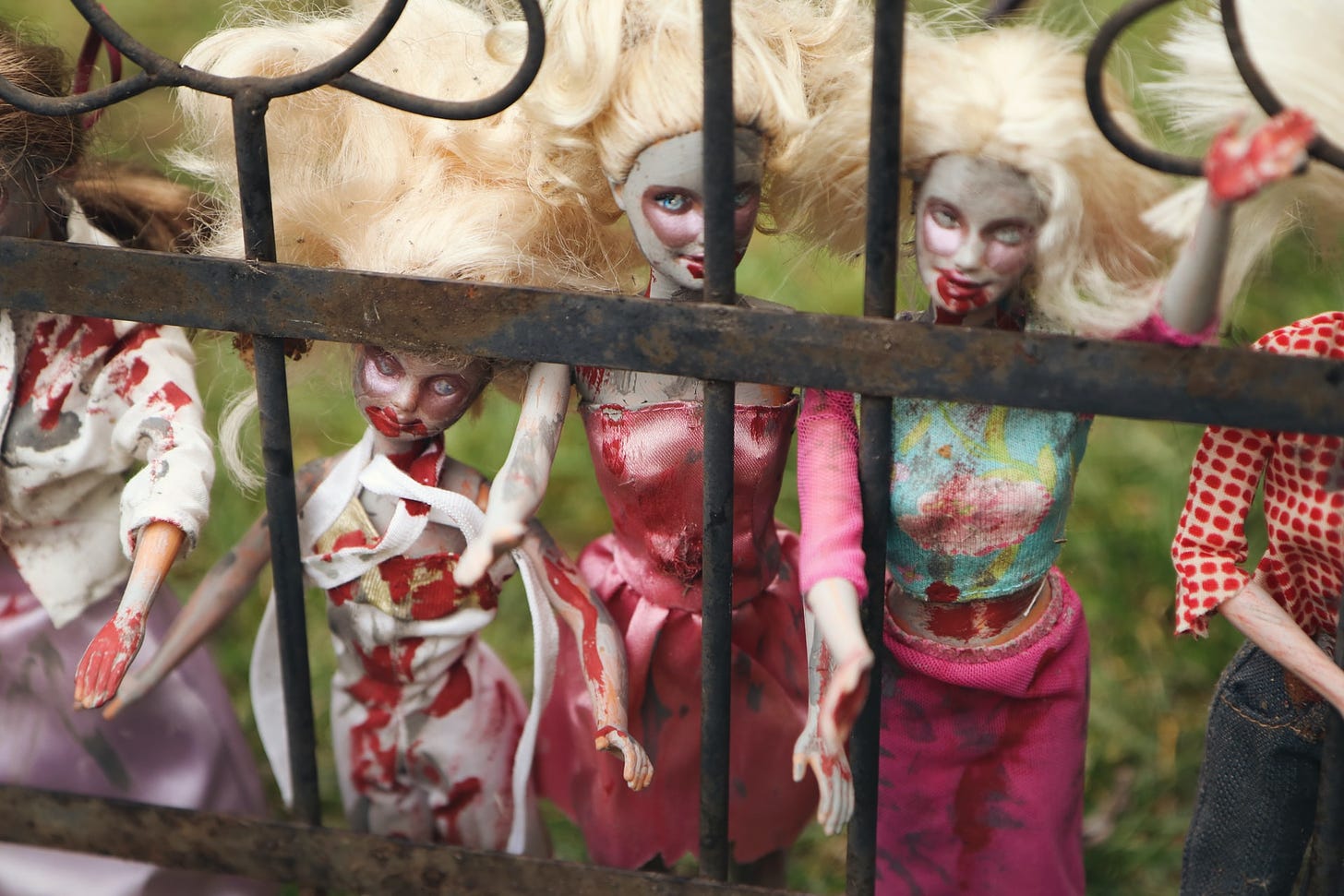Ask Virginia: Feminist Mom in a Barbie World
Banning Barbie is a bit like being the anti-McDonald's mom: It’s not that you’re wrong. But it takes a lot of privilege to be that strict.
Welcome to Burnt Toast, a newsletter from Virginia Sole-Smith, which you can read about here. If you like what you read today, please subscribe and/or share it with someone else who would too.
Q: I credit Barbie with my eating disorder (well, not sole responsibility, but some...). Now my daughter is also obsessed. She turned 8 this week and although I asked for experiences rather than tangible gifts, my mother-in-law went and got her two fancy Barbies. You can imagine how I screamed to my husband after they were handed to our child! Both he and Grandma thought it would be okay because she picked the bigger, curvy Barbies — but Big Barbie is still emaciated. I want to ask my daughter to pick out a replacement gift, but I worry about the trauma that would cause. And my husband thinks the work we do educating our kids about intuitive eating, HAES and thin privilege is enough to prevent any potential damage from Barbie. But I disagree — and I’m upset that my family isn’t allowing me to raise a resilient girl. What should we do?
A: Don’t hate me but... I’m with your husband on this one. Let’s imagine, for a second, that instead of two Barbies, Grandma had given your daughter a giant box of donuts. You already know that snatching the donuts away will only make a child crave them more — and maybe feel bad or ashamed for wanting them so much. (Newer readers, if you’re balking at that sentence, start here and then go here.) So in this scenario, Barbie is your unrefined sugar. Asking your daughter to pick out a replacement present will only underscore that there is something forbidden and therefore intensely alluring about these dolls. But if you just let her play with it and don’t make a fuss, the odds are good that these Barbies will end up forgotten at the bottom of a toy basket just like the Barbie in a pink push-up bra that my then-kindergartener brought home from school as a prize two years ago, and was excited about for maybe three days, but hasn’t looked at since.
Yes, I emailed her teacher to find out why they were giving out Barbies as rewards; it turned out that some other teacher had tapped a few of the kindergarteners to be “special helpers,” and happened to have a bunch of her own kids’ cast-off toys on hand, so she let them pick out whatever they wanted as a thank you. Which was odd but also kind of proves my point: Almost everyone moves on from Barbie eventually. Today’s beloved Birthday Barbie is tomorrow’s Garbage Barbie. It’s the circle of life/late stage capitalism.

All that said: Am I a Barbie fan? Not so much. As we all know, she represents a hilariously unattainable thin, white beauty ideal. There hasn’t been a ton of research on what that means for kids, but one new study on 31 girls aged 5 to 9 found that playing with ultra-thin Barbies and Monster High dolls induced a preference for thinner bodies, while playing with more realistic kid-shaped Lottie and Dora dolls had no such impact. Now that’s a small study, and we don’t know much about what context these kids had for Barbie — were they coming from families where the thin ideal was already intensely encouraged? But the results are compelling and do suggest to me that if you’re the one doll shopping, it’s better to buy dolls that look like children than dolls that look like wildly unrealistic adults.
What troubles me even more is how Barbie enables the hyper-gendering of children’s toys and children’s play. Although you can dress Barbie up to have lots of different jobs, her “success” is always inextricably linked to her appearance, and ability to hook Ken, which limits how girls play with her. In contrast, consider how many parents would — yes, still, today — recoil at giving a Barbie to their son, but not think twice about letting him play with toy guns. Kids of all genders need to explore all sorts of themes (both nurturing and violent) in their imaginative play. It’s not any individual Barbie (or toy gun) that’s the problem; it’s what Barbie replaces if she and other hyper-feminine toys (baby dolls, toy ironing boards, makeup kits, princess costumes) are the only form of play available to girls.
And you are right that Mattel’s attempt at body diversity with Curvy Barbie was a giant flop. They released her in 2016 as part of their “Barbie Fashionista” collection, which featured dolls of different skin tones and body types. Not only is she not particularly curvy — I wouldn’t say emaciated, but her measurements seem to translate to around a size 6 — she also, depressingly enough, appears to perpetuate weight stigma rather than fight it. When researchers asked 84 girls aged 3 to 10 to assign positive or negative traits to different Barbies (original, tall, petite, and curvy), the kids identified Curvy Barbie as the one they least wanted to play with, according to this 2019 study. “This tracks with our research that shows 3 year olds are also less likely to choose a child with a larger body to be their friend,” reports Jennifer Harriger, PhD, the study’s lead author and an associate professor of psychology at Pepperdine University who studies body image issues in children. What this really tells us is that giving kids Curvy Barbie is not going to magically de-program weight stigma all by itself. But it doesn’t mean the doll couldn’t be helpful (or at least benign) since you’re working on talking to your kids about fatphobia and diet culture in other ways. A few months ago, Mattel followed up with their new “Creatable World” Barbies, which allow children to customize almost every feature of their doll, including whether it’s a boy, a girl, or non-binary. This feels like fairly meaningful progress towards dismantling hyper-gendered play. And these dolls come in five different skin tones, and one is in a wheelchair. Yay representation! But their facial features are still largely Western European. And… they are all thin.

So we still need Fat Barbie, if for no other reason than: Barbies are so much more affordable than many other popular kid toy brands (looking right at you, American Girl!). As of this writing, I’m seeing curvy Barbie for anywhere from $8-17; Creatable World dolls are a bit more at $15-35 but that’s still way cheaper than the $84-140 you'll spend on a WellieWisher or Truly Me Doll. (Don’t even get me started on those faceless organic wool Waldorf dolls that cost a zillion dollars and I’m pretty sure no child has ever actually loved.) To go back to the sugar metaphor I started with, being too stringent about Barbie is a bit like being the anti-McDonald's mom: It’s not that you’re wrong. But it takes a lot of privilege to be that strict.
And despite the study findings I’ve covered here — I’m not at all sure that banning Barbie is necessary to raise a resilient girl. What girls — and all kids — really need to be resilient in the face of diet culture is a combination of critical thinking skills and the fundamental knowledge that their value is not tied to their appearance. When they have those tools, Barbie, Monster High, Bratz dolls, Disney princesses, and every other Kid Diet Culture brand all have so much less power. And if they know they can explore these trends without losing your respect or facing your judgment, it’s a lot safer for them to give it a whirl, and then maybe come to you with questions or even just quietly decide on their own that it’s not that great.

In writing all of this, I don’t mean to discount how toxic Barbie was for you and your own eating disorder struggles. But it sounds like you’re already working hard to give your daughter tools that maybe you didn’t have access to at her same age. So let her enjoy the Birthday Barbies now. And sure, have a conversation with your mother-in-law before the next gift-giving opportunity arises; you can share why Barbie triggers you, or talk about the research finding that kids get more out of playing with dolls that look like them (or at least are their same age), or just suggest some other less-stringently-gendered gifts that you know your daughter would love. Just remember that our goal isn’t to keep them in diet culture-free bubbles forever—as lovely as that sounds!—it’s to help them navigate diet culture whenever it shows up. And I’m so sorry it’s showing up now, at age 8, pink convertible and all. But I think you’re both ready for it.
ALSO
Weighing parents by their child’s scale: For Slate, I wrote about a troubling case in the U.K. in which two children were removed from their family because of their weight — demonstrating a gross misunderstanding of how dieting works (it usually doesn’t!), as well as child well-being. And this is only one of dozens of similar cases in the U.S. and U.K. Read more here.
Love your pandemic body: As I wrote in the newsletter last week, we’re still talking about pandemic weight gain. But as I write this week in Good Housekeeping, “Everyone still standing right now has survived a life-changing amount of collective trauma. We are all different than we were 13 months ago; we will never again be our pre-pandemic selves. And so it makes sense that our bodies are different too. Bodies aren’t meant to remain the same throughout our lives. We can and should mourn what we’ve lost. But we should also celebrate, or at least find peace with, what we’ve gained.” Read the whole thing here.
You’re reading Burnt Toast, a newsletter by Virginia Sole-Smith. Virginia is a feminist writer, and author of The Eating Instinct and the forthcoming Fat Kid Phobia. Comments? Questions? Email Virginia.
If a friend forwarded this to you and you want to subscribe, sign up here:



